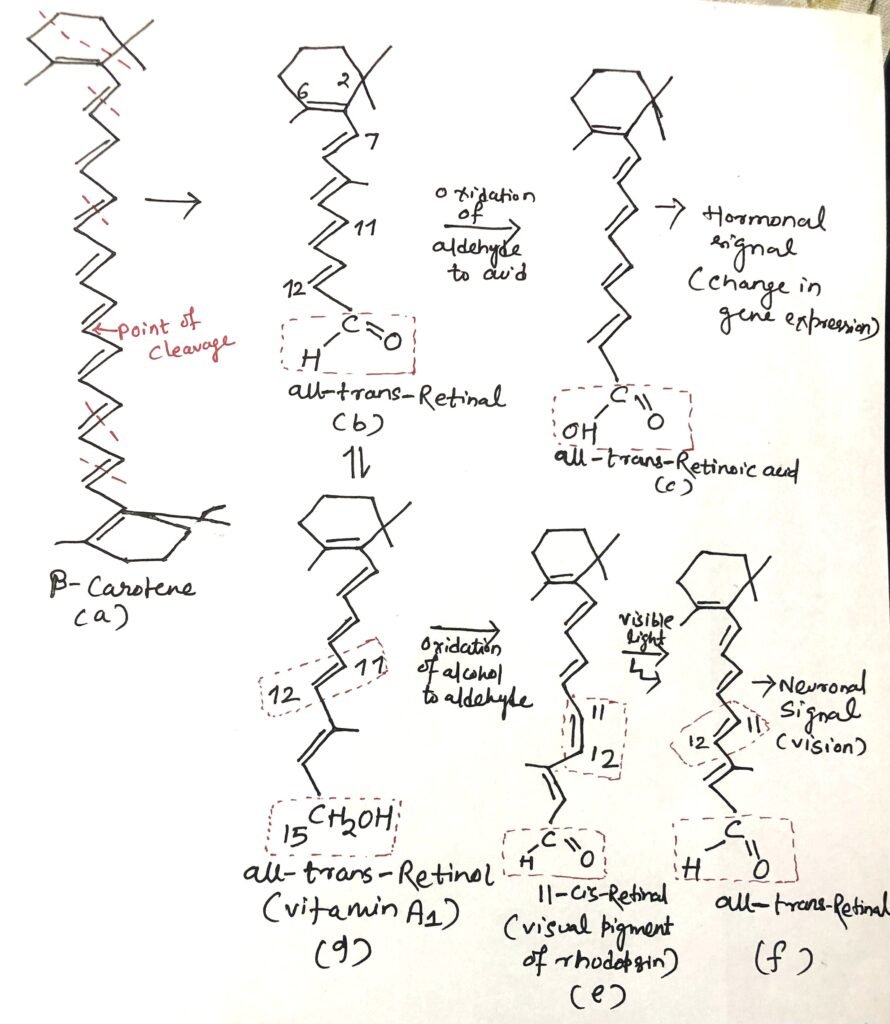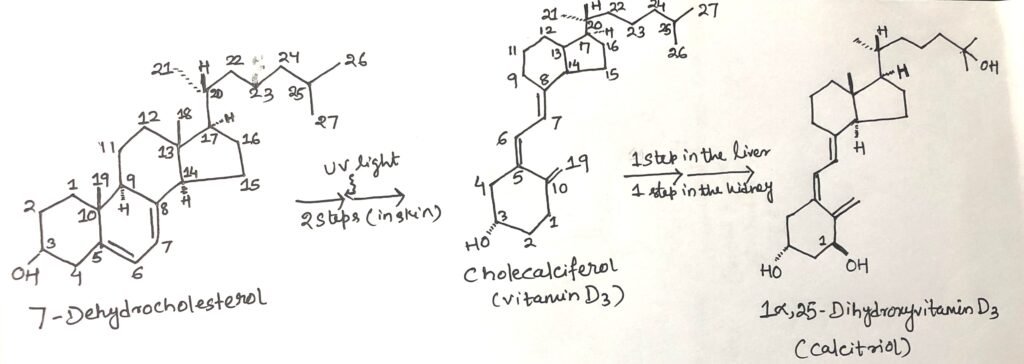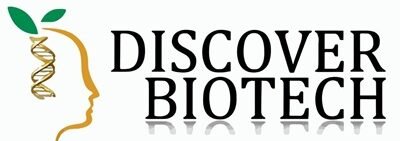In this article, I briefly describe fat-soluble vitamins and their importance in the human body.
Fat-Soluble Vitamins
In the early decades of the 20th century, one of the most exciting frontiers in physiological chemistry was the discovery of vitamins—tiny but vital compounds that play a crucial role in maintaining health. Since humans and other vertebrates cannot produce these nutrients independently, they must rely on their diet to obtain them. These nutrients are broadly categorized into two types: fat-soluble and water-soluble vitamins. Fat-soluble vitamins include vitamins A, D, E, and K, which are all classified as isoprenoid compounds. These vitamins are formed through the condensation of several isoprene units.
Vitamin A
It is a fat-soluble vitamin that is vital for numerous functions in the body. Unlike most vitamins, vitamin A can be stored for some time in the body. Vitamin A is particularly important for maintaining clear vision in dim light, supporting the immune system, aiding reproduction, and facilitating proper cell function. This vitamin comes in two main forms: preformed vitamin A (such as retinol and its derivatives) found in animal-based foods (eggs, whole milk, and butter, and provitamin A carotenoids (like beta-carotene) found in plant sources (carrots, sweet potatoes, and other yellow vegetables), which the body can convert into the active form. Carotene is one of the myriad carotenoids, natural products with a characteristic extensive system of conjugated double bonds, which makes possible their strong absorption of visible light (450-470 nm).
Vitamin A1
Vitamin A₁, also known as all-trans-retinol (Figure 1), is the most biologically active form of vitamin A found in animal sources. It is a fat-soluble compound that plays a vital role in vision (particularly in forming the visual pigment rhodopsin in the retina), as well as in growth, immune function, and maintaining healthy skin and mucous membranes. Its oxidized metabolites, retinoic acid and retinal, also act in development, cell growth, differentiation, and vision.

Dietary vitamin A₁ or β-carotene (Figure 1) can be enzymatically converted into all-trans-retinoic acid. It is a retinoid hormone that influences gene expression by interacting with nuclear receptors, including RAR, RXR, and PPAR. β-carotene is symmetrically cleaved into two molecules of all-trans-retinal, which can be either oxidized into all-trans-retinoic acid or reduced to all-trans-retinol, vitamin A1. In the visual pathway, all-trans-retinol obtained from this reaction or directly from the diet can be converted to the aldehyde 11-cis-retinal. This combines with the protein opsin to form rhodopsin. In the dark, the retinal of rhodopsin is in the 11-cis form. When a rhodopsin molecule is excited by visible light, the 11-cis-retinal undergoes a series of photochemical reactions that convert it into all-trans-retinal, forcing a change in the shape of the entire rhodopsin molecule (Figure 1).
The retinoid hormone, all-trans-retinoic acid, plays a key role in embryonic development, stem cell differentiation, and cell growth. Clinically, all-trans-retinoic acid is used in treating certain forms of leukemia. It is also the active component in tretinoin (Retin-A), a medication for severe acne and aging-related skin conditions like wrinkles.
Effects of a Deficiency of Vitamin A
A deficiency of vitamin A during pregnancy can result in birth defects and stunted growth in the baby. In adults, it can cause symptoms such as dry skin, dry eyes, dryness of mucous membranes, and night blindness—one of the earliest and most recognizable signs of this deficiency.
An effective approach to addressing vitamin A deficiency involves genetically modifying rice to produce higher levels of β-carotene. While rice plants naturally produce β-carotene in their leaves, the necessary enzymes are less active in the grains. By introducing two specific genes into rice, scientists have developed “golden rice,” a variety with grains significantly enriched in β-carotene.
Vitamin D
It is a fat-soluble vitamin that supports bone health, immune function, and overall well-being. Unlike most vitamins, it can be synthesized by the body when the skin is exposed to sunlight. Vitamin D plays a key role in calcium and phosphorus absorption in the gut and helps regulate immune function. Inadequate levels of vitamin D can lead to weakened bones, increased risk of fractures, and, in severe cases, disorders such as rickets in children and osteomalacia in adults.
Vitamin D3, known as cholecalciferol, is typically produced in the skin through a photochemical reaction involving 7-dehydrocholesterol and ultraviolet (UV) rays from sunlight. Although vitamin D3 is not biologically active, it undergoes enzymatic conversion in the liver and kidneys to form 1α,25-dihydroxyvitamin D3 (calcitriol). In the liver, a hydroxyl group is added at C-25, and in the kidney, a second hydroxylation at C-1 produces the active hormone, 1-α, 25-dihydroxyvitamin D3 (Calcitriol) (Figure 2). Calcitriol is a hormone that plays a crucial role in regulating calcium absorption in the intestines and maintaining calcium balance in the kidneys and bones.

Vitamin D deficiency results in improper bone development, leading to rickets, which can be treated with vitamin D supplementation. Vitamin D2, a commercially available form, is produced by exposing ergosterol from yeast to UV light. It resembles vitamin D3, differing slightly in the side chain attached to the sterol D ring. Despite this structural variation, both forms have similar biological functions. Vitamin D2 is often added to foods like milk and butter to improve dietary intake. The active form of vitamin D, 1α,25-dihydroxyvitamin D3, regulates gene expression by binding to specific nuclear receptor proteins.
Vitamin E
Vitamin E is a fat-soluble vitamin known for its strong antioxidant properties, protecting cell membranes from damage caused by free radicals. The most active form, α-tocopherol, supports immune function, skin health, and cellular processes. Vitamin E is found in foods like vegetable oils, nuts, and leafy green vegetables. It is essential for overall health, and its deficiency can lead to nerve and muscle damage.
Vitamin E (Figure 3) refers to a group of closely related lipids known as tocopherols, which all share a substituted aromatic ring structure and a long isoprenoid side chain. Due to their hydrophobic nature, tocopherols associate with cell membranes, lipid stores, and lipoproteins in the bloodstream. They function as biological antioxidants, with the aromatic ring neutralizing highly reactive oxygen species and other free radicals. This action helps protect unsaturated fatty acids from oxidative damage. It also maintains the integrity of membrane lipids, thereby preventing cellular fragility.

Tocopherols are present in foods such as eggs and vegetable oils, with particularly high levels found in wheat germ. Although vitamin E deficiency is uncommon in humans, its primary symptom is the increased fragility of red blood cells (erythrocytes).
Vitamin K
Vitamin K is a fat-soluble vitamin essential for blood clotting and bone metabolism. It plays a crucial role in synthesizing certain proteins required for coagulation and regulating calcium binding in bones and other tissues. There are two main natural forms of vitamin K: vitamin K₁ (phylloquinone) (Figure 4) and vitamin K₂. Vitamin K₁ is found in green leafy vegetables, and vitamin K₂ (menaquinone), produced by gut bacteria and present in fermented foods and animal products. Although deficiency is rare, it can lead to bleeding disorders due to impaired clotting.

During blood clotting, the aromatic ring of vitamin K participates in a redox cycle essential for producing active prothrombin, a plasma protein critical to coagulation. Prothrombin is a proteolytic enzyme that cleaves fibrinogen, a soluble protein. Fibrinogen is cleaved to form fibrin, an insoluble fibrous protein that stabilizes the blood clot.
Henrik Dam and Edward A. Doisy independently linked vitamin K deficiency to impaired clotting. Although such a deficiency is rare in adults, it can lead to serious complications. In some newborns, it causes hemorrhagic disease, a potentially fatal bleeding disorder.
Conclusion
Fat-soluble vitamins include vitamins A, D, E, and K, which are all classified as isoprenoid compounds. Vitamin A is a fat-soluble vitamin essential for vision in low light, immune function, reproduction, and healthy cell activity. It exists as preformed vitamin A in animal products and as provitamin A carotenoids in plant sources like carrots and sweet potatoes. Beta-carotene, a key carotenoid, strongly absorbs visible light. It is due to its conjugated double bonds and is converted by the body into active vitamin A.
Vitamin D is a fat-soluble vitamin essential for bone health, immune support, and calcium-phosphorus absorption. It is synthesized in the skin upon sunlight exposure as vitamin D3 (cholecalciferol), which is later converted into the active hormone calcitriol. Calcitriol regulates calcium balance in the gut, kidneys, and bones. Deficiency can lead to rickets in children and osteomalacia in adults.
Vitamin E is a fat-soluble antioxidant that protects cell membranes from oxidative damage by neutralizing free radicals. Its most active form, α-tocopherol, supports immune function, skin health, and cellular stability. Tocopherols, due to their hydrophobic nature, associate with membranes and lipids, helping maintain membrane integrity. Deficiency can lead to nerve and muscle damage.
Vitamin K is a fat-soluble vitamin essential for blood clotting and bone metabolism. It plays a crucial role in synthesizing certain proteins required for coagulation. It regulates calcium binding in bones and other tissues.

I, Swagatika Sahu (author of this website), have done my master’s in Biotechnology. I have around fourteen years of experience in writing and believe that writing is a great way to share knowledge. I hope the articles on the website will help users in enhancing their intellect in Biotechnology.




